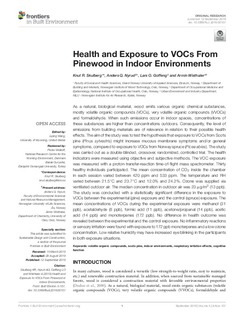| dc.contributor.author | Skulberg, Knut Ragnvald | |
| dc.contributor.author | Nyrud, Anders Q. | |
| dc.contributor.author | Goffeng, Lars Ole | |
| dc.contributor.author | Wisthaler, Armin | |
| dc.date.accessioned | 2020-01-09T08:00:08Z | |
| dc.date.available | 2020-01-09T08:00:08Z | |
| dc.date.created | 2019-09-25T09:11:33Z | |
| dc.date.issued | 2019 | |
| dc.identifier.issn | 2297-3362 | |
| dc.identifier.uri | http://hdl.handle.net/11250/2635436 | |
| dc.description.abstract | As a natural, biological material, wood emits various organic chemical substances, mostly volatile organic compounds (VOCs), very volatile organic compounds (VVOCs) and formaldehyde. When such emissions occur in indoor spaces, concentrations of these substances are higher than concentrations outdoors. Consequently, the level of emissions from building materials are of relevance in relation to their possible health effects. The aim of the study was to test the hypothesis that exposure to VOCs from Scots pine (Pinus sylvestris) might increase mucous membrane symptoms and/or general symptoms, compared to exposure to VOCs from Norway spruce (Picea abies). The study was carried out as a double-blinded, crossover, randomized, controlled trial. The health indicators were measured using objective and subjective methods. The VOC exposure was measured with a proton-transfer-reaction time-of-flight mass spectrometer. Thirty healthy individuals participated. The mean concentration of CO2 inside the chamber in each session varied between 420 ppm and 533 ppm. The temperature and RH varied between 21.5°C and 23.7°C and 12.0% and 24.2%. Ozone was supplied via ventilated outdoor air. The median concentration in outdoor air was 23 μg/m3 (13 ppb). The study was conducted with a statistically significant difference in the exposure to VOCs between the experimental (pine) exposure and the control (spruce) exposure. The mean concentrations of VOCs during the experimental exposure were methanol (31 ppb), acetaldehyde (8 ppb), formic acid (11 ppb), acetone/propanal (14 ppb), acetic acid (14 ppb) and monoterpenes (172 ppb). No difference in health outcome was revealed between the experimental and the control exposure. No inflammatory reactions or sensory irritation were found with exposure to 172 ppb monoterpenes and a low ozone concentration. Low relative humidity may have increased eye blinking in the participants in both exposure situations. | nb_NO |
| dc.language.iso | eng | nb_NO |
| dc.rights | Navngivelse 4.0 Internasjonal | * |
| dc.rights.uri | http://creativecommons.org/licenses/by/4.0/deed.no | * |
| dc.title | Health and Exposure to VOCs From Pinewood in Indoor Environments | nb_NO |
| dc.type | Journal article | nb_NO |
| dc.type | Peer reviewed | nb_NO |
| dc.description.version | publishedVersion | nb_NO |
| dc.rights.holder | © 2019 Skulberg, Nyrud, Goffeng and Wisthaler | nb_NO |
| dc.source.volume | 5 | nb_NO |
| dc.source.journal | Frontiers in Built Environment | nb_NO |
| dc.identifier.doi | 10.3389/fbuil.2019.00107 | |
| dc.identifier.cristin | 1728646 | |
| dc.relation.project | Norges forskningsråd: 216404 | nb_NO |
| cristin.unitcode | 7460,0,0,0 | |
| cristin.unitname | NILU - Norsk institutt for luftforskning | |
| cristin.ispublished | true | |
| cristin.fulltext | original | |
| cristin.qualitycode | 1 | |

